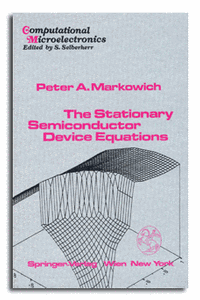Book Information

The Stationary Semiconductor Device Equations
- Author: Markowich, Peter A.
- Published: 1986, 193 pages, 40 figures
- ISBN: 978-3-211-81892-3 (Hardcover), 978-3-7091-3678-2 (eBook)
- Information from Amazon
Abstract:
The static semiconductor device problem is treated in an äapplied mathematicsô way. The device equations are derived from physical principles; qualitative properties like existence, uniqueness, continuous dependence-on-data, and regularity of solutions are analysed by means of the modern theory of elliptic boundary value problems, and singular perturbation methods are employed to investigate the structure of solutions. This analysis describes depletion layer phenomena qualitatively and quantitatively. Physical interpretations of the mathematical results are given and pitfalls of the physical model are discussed. The structural results obtained by the singular perturbation analysis serve as a basis for the derivation and convergence analysis of numerical discretisation techniques, i.e. of finite element and finite difference methods. The monograph provides device modelers with the basic mathematical results and techniques necessary for designing efficient simulation programs and for a profound interpretation of simulation results. Also, it serves as a source of mathematically challenging problems for researchers in numerical analysis, singular perturbation theory, and p.d.e. analysis.
